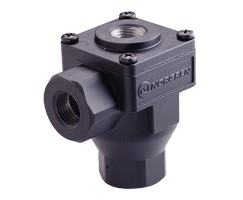

Actuators are the unsung heroes of pneumatic systems. These small and simple devices help power your systems by controlling the flow of air and fluids, something we know a lot about. But what does an actuator do, and how does an actuator work? We have the answers to these questions and more. Let’s find out about these critical but humble components of a pneumatic system.
The actuator in a pneumatic system is a device that converts the energy of compressed air into mechanical motion. This is essential in a wide range of industrial applications, from manufacturing to automation, transportation, and construction. The mechanical motion it creates regulates the flow of air through a pneumatic system, giving its operators control. They can also be automated or operated remotely in some applications. Depending on the design of the actuator, and how it is being used, its motion can be either linear or rotary, and they can manipulate a wide range of components including dampers, valves, and inlet vanes with a granular level of control.
In a pneumatic system, compressed air is released from a storage tank, and flows through a network of pipes and tubes to reach critical pneumatic components like cylinders and actuators. The actuators then use this compressed air pressure to move parts or to control mechanical operations.
Linear actuators will usually move a piston back and forth inside a cylinder to build pressure and ‘actuate’, or complete an action. This could be moving a product down a production line or operating a machine as part of a production process. Although linear actuators have been around for a long time, advances in material science and production methods have moved the technology forward significantly in recent years allowing for even more uses for linear actuators and increased reliability.
Rotary actuators work slightly differently but the principles of their operation remain the same. This type of actuator generates torque through a rotational motion that is used to complete its designated action. Linear motion can be used to rotate the actuator, and a rotary actuator can also be used in reverse to generate a linear action from the rotation of the components inside the actuator.
Pneumatic actuators, like the ones we supply made by Norgren, are chosen for their reliability, safety, flexibility, efficiency, and cost-effectiveness. They are advantageous in applications where electricity or hydraulics are not practical. Fluid Controls supplies actuators for a broad range of industries. Our actuators are used extensively in:
In all of these applications, reliability and safety are paramount concerns. That is why we use Norgren actuators which are well-known for their precision and reliability, making them a cost-effective choice for all of our customers. Not only do they provide reliability but they can also be used in just about any system, making them a flexible and adaptive component to use in your pneumatic system no matter what industry you operate in.
We stock Norgren actuators and valves exclusively. They are renowned for their quality, reliability, and safety. We accept nothing less than the best in the business, and neither should you. Our wide range ensures that you can find the right type of actuator for your system no matter what industry you work in or how you use pneumatics. The Norgren range includes both rodded and rodless actuators as well as compact, roundline, and guided actuators in styles and sizes to suit all requirements. Not only do we understand what an actuator does and how they work, but we also understand the importance of quality components and how your business relies on the quality of our products. All of our pneumatic system components are made to the highest standards from the highest quality of materials available, giving you a pneumatic system that you can rely on for continuous operation and safety.
Understanding the role and functionality of actuators is crucial to the safe operation of pneumatic systems. Whether in manufacturing, automotive, aerospace, or medical industries, the right actuator can significantly enhance efficiency and precision.
We hope this article has been informative in answering the questions of how does an actuator work and what does an actuator do.
Fluid Controls stands at the forefront of supplying these vital components, backed by our commitment to quality and customer service. If you want to know more about actuators and the role they can play in your industry, get in contact with us. We can advise you on the best actuators for your existing system, or help you create a new pneumatic system from the ground up that offers reliability, safety, accuracy, and value.